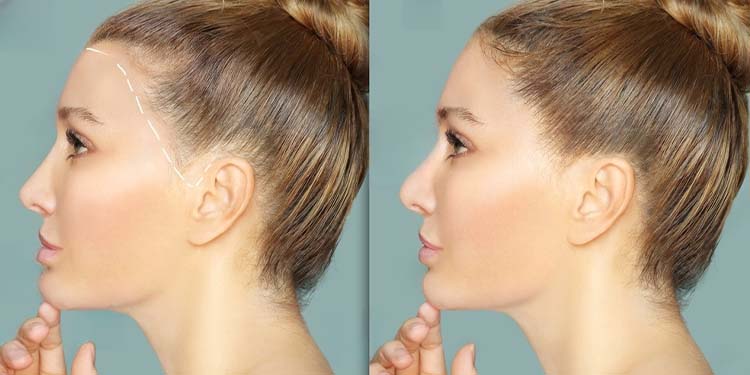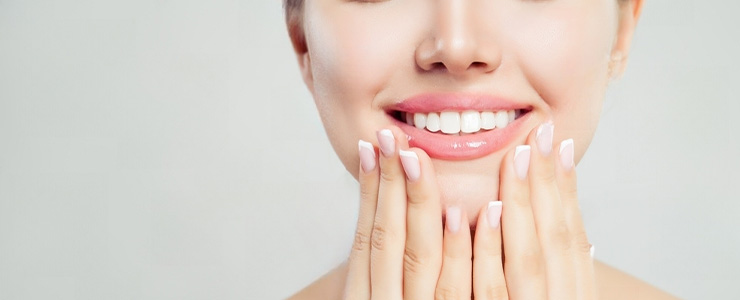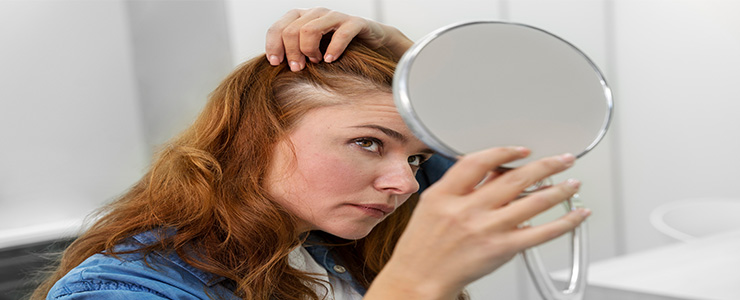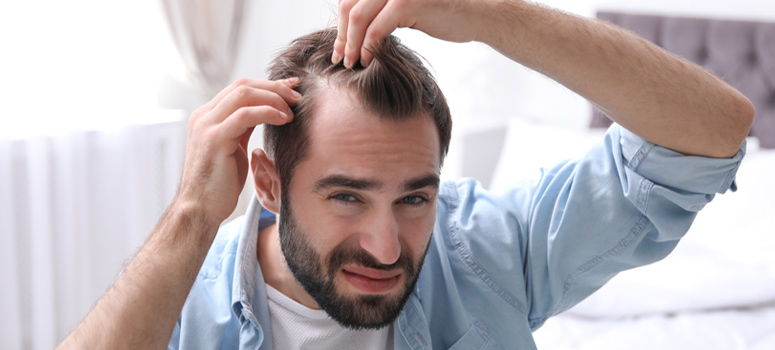What is Female Pattern Baldness?
Female pattern baldness, also known as androgenetic alopecia, is a common type of hair loss that affects women. Female pattern hair loss is characterized by a gradual and progressive loss of hair on the scalp, typically in a specific pattern. While hair loss is often associated with men, women can also experience thinning and shedding of hair.
Unlike men who tend to develop receding hairlines and bald spots, women with female pattern baldness usually experience thinning throughout the scalp. The hair may become noticeably thinner, and the parting line may widen over time. This condition can have a significant impact on a woman’s self-esteem and emotional well-being, as hair is often considered an important aspect of femininity and beauty.
Stages of Female Pattern Baldness
Female pattern baldness typically progresses gradually over time, following a distinct pattern. The condition is often categorized into different stages to help assess the severity of hair loss. Although the stages may vary slightly depending on the classification system used, the general stages of female hair loss are as follows:
- Stage 1: In the initial stage, there may be minimal or no visible hair loss. The hair appears normal, and there are no noticeable changes in hair volume or density.
- Stage 2: As the condition progresses to stage 2, there is a widening of the part line and increased hair shedding. Hair loss becomes more evident, especially around the crown or top of the scalp. The hair thinning in women becomes apparent, and the scalp may become more visible.
- Stage 3: At this stage, the hair loss becomes more noticeable and significant. Thinning of hair is more pronounced, and the scalp becomes increasingly visible. The hairline may recede, and there may be a more noticeable reduction in hair density.
- Stage 4: In this advanced stage, hair loss is more severe, with extensive thinning and a significant reduction in hair volume. The scalp is highly visible, and there may be a distinct separation between the remaining hair and bare areas on the scalp.
It’s important to note that not all women will progress through all stages of female pattern baldness. The progression and severity of hair loss can vary from person to person.
Female Pattern Baldness Causes:
While the exact female pattern hair loss cause is not fully understood, several contributing factors have been identified, such as:
- Hormonal Imbalance: Hormonal changes can contribute to hair loss in women. Androgens, including testosterone and dihydrotestosterone (DHT), are naturally present in women but at lower levels than in men. However, in women with female pattern baldness, hair follicles may become more sensitive to the effects of these androgens, leading to miniaturization of the hair follicles and subsequent hair loss.
- Age-Related Factors: Age is another factor that can contribute to female pattern baldness. The condition often becomes more prevalent and noticeable with advancing age, particularly after menopause. This is believed to be due to hormonal fluctuations associated with menopause and the gradual reduction of estrogen levels.
- Genetic Predisposition: Family history plays a significant role in female pattern baldness. Having a close relative, such as a mother, sister, or grandmother, with the condition increases the likelihood of developing it. Genetic susceptibility is thought to contribute to the sensitivity of hair follicles to androgens, the male hormones present in both men and women.
- Other Medical Conditions: Certain underlying medical conditions, such as polycystic ovary syndrome (PCOS), thyroid disorders, and autoimmune conditions, may contribute to female pattern baldness. These conditions can disrupt hormonal balance and even cause female pattern baldness in the 20s.
Symptoms of Female Pattern Baldness
While the pattern and severity of symptoms may vary from person to person, the following are common signs of female pattern baldness:
- Thinning Hair: The most prominent symptom is a gradual thinning of hair on the scalp. Women with female pattern baldness often notice that their hair becomes noticeably thinner, lacking the volume and density it once had. The thinning may be more pronounced in certain areas, such as the crown or top of the head.
- Decreased Hair Density: Hair loss associated with female pattern baldness often leads to a reduction in hair density. The overall amount of hair on the scalp decreases, resulting in a thinner overall appearance. Women may notice that their hair feels less full and lacks the thickness it once had.
- Widening Part Line: Another common symptom is a widening of the part line. As hair loss progresses, the part line may become more visible and broader due to the thinning of hair in that area. This can make the scalp more apparent, especially when hair is styled or parted.
- Receding Hairline: While male pattern baldness often involves a receding hairline, women with female pattern baldness typically retain their frontal hairline. However, in some cases, a receding hairline may occur, but it is less common compared to men.
It is important to note that female pattern baldness progresses gradually over time, and the symptoms may worsen as the condition advances.
Diagnosis & Female pattern baldness treatment
- Diagnosis:To diagnose female pattern baldness, a dermatologist or healthcare professional will typically perform a thorough evaluation of your medical history, conduct a physical examination, and may order additional tests to rule out underlying medical conditions contributing to hair loss. They will assess the pattern and severity of hair loss, examine the scalp, and evaluate the overall health of your hair and follicles.
- Treatment:There are various options available for female pattern hair loss treatment and manage hair loss in women. The choice of hair loss treatment for women depends on factors such as the extent of hair loss, individual preferences, and overall health. Some treatment options include:
- Medications: Prescription medications such as minoxidil (Rogaine) and finasteride (Propecia) may be recommended to slow down hair loss, promote hair regrowth, and increase hair density. These medications work by stimulating hair follicles and preventing further hair thinning.
- Low-Level Laser Therapy (LLLT): LLLT involves the use of specialized devices that emit low-intensity laser light to stimulate hair growth. This non-invasive treatment can be performed at home or in a clinical setting and may help improve hair density and promote regrowth.
- Hair Transplant: In some cases, hair transplant procedures may be considered, especially if other treatments have not provided satisfactory results. Female hair transplants involve the transplantation of healthy hair follicles from one area of the scalp to areas experiencing hair loss. It is important to note that the techniques for male vs female hair transplants are different and considerations for female hair transplants may differ from those used in male hair transplants.
- Lifestyle Modifications: Making certain lifestyle changes can support overall hair health and potentially slow down the progression of hair loss. This may include adopting a balanced diet rich in essential nutrients, managing stress levels, avoiding harsh hair treatments or hairstyles that pull on the hair, and practising good scalp hygiene.
Conclusion
Don’t let female pattern baldness hold you back from having the hair you desire. Take the next step towards understanding and managing your hair loss by consulting with a local dermatologist or hair specialist. They are the experts who can provide personalized advice and effective treatment options based on your unique needs.
Finding a qualified professional is made easy with our Find Local Dermatologist page where you can discover dermatologists near you who specialize in hair and scalp conditions. By connecting with a local expert, you can embark on a journey to address female pattern baldness and achieve healthier, fuller hair.
Remember, taking action early can make a significant difference in managing hair loss. Don’t hesitate to take the first step towards regaining your confidence and achieving your hair goals. Schedule a consultation with a local dermatologist today and take control of your hair health.
FAQs on Female Pattern Baldness
1) Can hair grow back from female pattern baldness?
In some cases, hair regrowth is possible with appropriate treatment. It is essential to consult with a dermatologist or hair specialist to determine the best course of action based on the individual’s specific condition.
2) What triggers female pattern hair loss?
The exact cause of female pattern baldness is not fully understood, but it is thought to be a combination of genetic and hormonal factors. Women with a family history of hair loss are more likely to develop the condition. Hormonal changes that can trigger female pattern baldness include menopause, childbirth, and the use of certain medications.
3) What is Stage 1 female pattern baldness?
Stage 1 female pattern baldness refers to the initial phase of hair loss in women. It is characterized by mild thinning of hair, usually around the part line or crown area. The hairline remains unaffected at this stage.
4) What vitamin deficiency causes female hair loss?
Several vitamin deficiencies can contribute to hair loss in women. One common example is a deficiency in iron, which can lead to a type of hair loss known as telogen effluvium. Other nutrient deficiencies, such as vitamin D, vitamin B12, and zinc, also impact hair health.
5) Is female baldness rare?
Female pattern baldness is not as common as male pattern baldness but still affects a significant number of women. It is estimated that around 30% of women experience hair loss to some degree in their lifetime.














